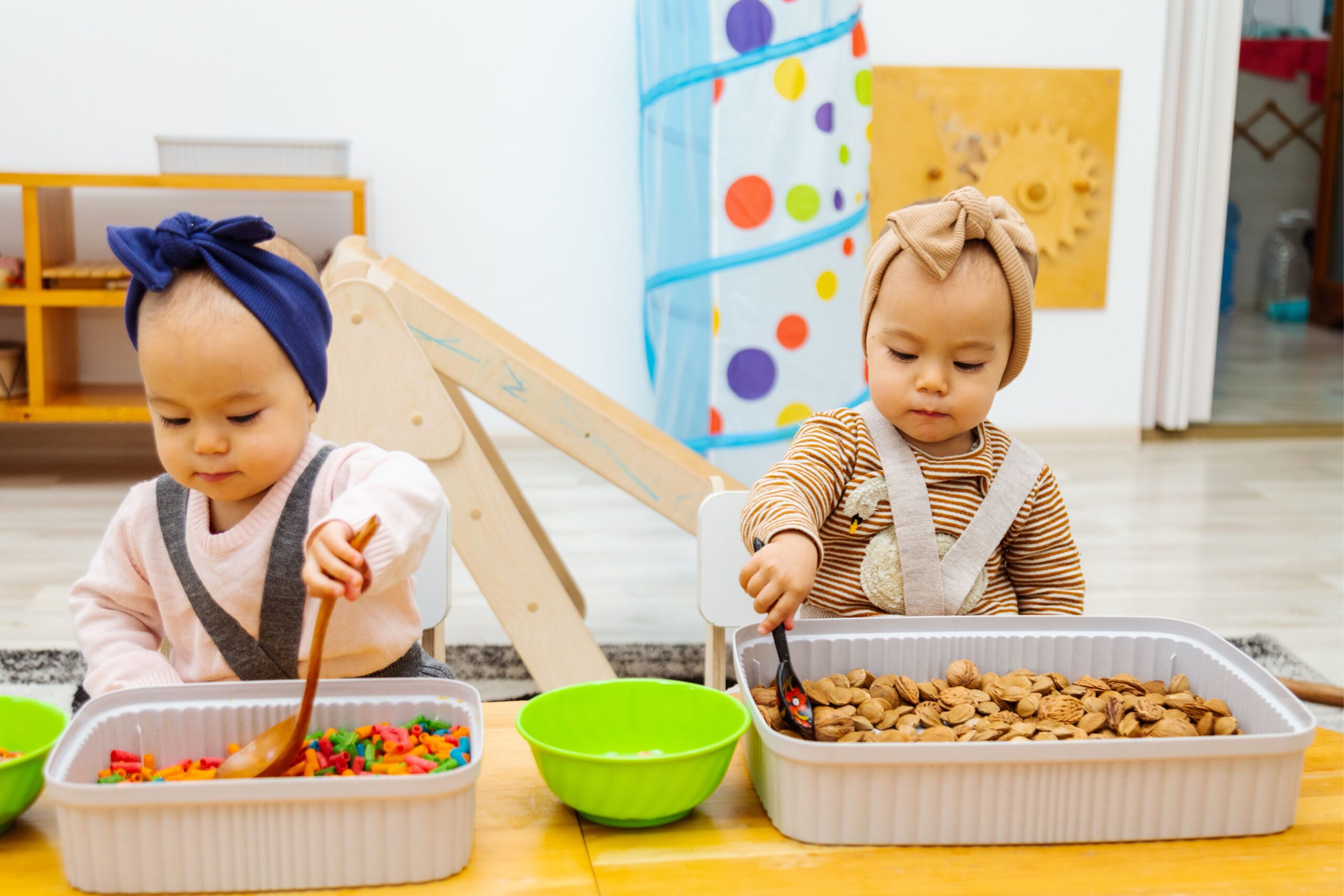Are you a new parent eager to foster your baby’s growth and development through Baby Sensory Tables? If so, you’ve likely come across the term “sensory play” during your research. But what exactly is sensory play, and why is it so important for your little one’s development?
Join us as we unlock the secrets of sensory play and empower you with practical tips to incorporate it into your everyday life. Let’s embark on this exciting adventure together and discover how sensory play can truly transform your baby’s development.
Benefits of Sensory Play for Babies
Sensory development plays a crucial role in the overall cognitive and physical development of babies. Through sensory play, infants engage their senses, explore their environment, and learn about the world around them. Let’s delve into the benefits of sensory play for baby development.
Enhancing Cognitive Development
Babies engage with the world through their senses, and sensory play provides them with valuable opportunities to enhance their cognitive development. Through activities that stimulate their senses, babies develop important cognitive skills such as problem-solving, cause-and-effect reasoning, and spatial awareness.
Promoting Fine Motor Skills
Sensory play activities often involve manipulating various materials and objects, which helps babies develop and refine their fine motor skills. Scooping, pouring, pinching, and grasping objects during sensory play helps strengthen the muscles in their hands and fingers, improving their ability to perform intricate movements.
Encouraging Language Development
Sensory play presents numerous opportunities for babies to engage in meaningful communication and language development. As they interact with different textures, objects, and materials, babies are encouraged to verbalize their experiences and describe what they see, hear, and feel. This verbal expression helps expand their vocabulary and develop their language skills.
Stimulating Social and Emotional Growth
Sensory play provides babies with valuable opportunities to explore and understand their emotions and the emotions of others. As they engage with different sensory materials, babies experience a range of sensory stimulations that can help them recognize and regulate their own emotions. The tactile nature of sensory play also encourages babies to engage in self-soothing behaviors and promotes a sense of calm and relaxation.
Fostering Sensory Integration
Sensory play is particularly beneficial for babies who may struggle with sensory processing or sensory integration. By exposing babies to different textures, smells, tastes, sounds, and visual stimuli, sensory play activities create opportunities for
Types of Sensory Tables
Sensory play is a fantastic way to stimulate a baby’s senses and promote their overall development. One effective method of incorporating sensory play into a child’s routine is through the use of sensory tables. These tables are specially designed to engage a child’s senses and provide them with a hands-on learning experience. Here we will explore four types of baby sensory tables commonly used for baby development:
1. Water Sensory Tables: Water tables are a perennial favorite among babies and young children. Filled with water and various water toys, they provide endless opportunities for tactile 0exploration and sensory stimulation. Splashing, pouring, and feeling the different water temperatures all contribute to a baby’s sensory development.
2. Sand Sensory Tables: Sand tables are another popular choice when it comes to sensory play. Filled with soft sand, babies can dig, mold, and create shapes, stimulating their sense of touch and promoting cognitive development. The texture of the sand can be soothing and therapeutic for babies, encouraging their sensory exploration.
3. Sensory Bin Tables: Sensory bin tables combine a variety of sensory materials such as rice, beans, or colored pasta in containers or bins. These tables provide a multi-sensory experience, allowing babies to explore different textures, colors, and sounds. Sensory bins promote cognitive development, language skills, and social interaction as babies engage with the materials and play alongside others.
4. Nature Sensory Tables: Nature sensory tables bring the outdoors inside and give babies a chance to explore different natural elements. They can include items like leaves, flowers, acorns, or pinecones. This type of sensory play helps babies connect with nature, stimulates their senses, and fosters curiosity about the world around them.
DIY Sensory Tables for Babies
Here are some ideas and tips to help you design your own sensory table for your little one:
1. Selecting the right materials:
Use a shallow container or table with rounded edges to ensure the safety of your baby.
Opt for materials that are easily washable and non-toxic, such as plastic or waterproof fabric.
Consider natural materials like sand, water, rice, or pasta that provide different textures and sensory experiences.
2. Sensory materials and activities:
Fill one section of the table with colored rice or pasta. This will engage your baby’s sense of touch and sight as they explore the different colors and textures.
Include a section with water for babies to splash and play with. Place a few floating toys or objects with different textures for added sensory stimulation.
Add a section with kinetic sand or playdough. This will stimulate your baby’s fine motor skills as they mold and manipulate the material.
Include a variety of objects with different shapes, sizes, textures, and sounds. This will provide your baby with sensory exploration and object permanence learning.
3. Incorporating educational elements:
Integrate letters, numbers, or shapes into the sensory activities. For example, you can hide foam letters in a bin of sand for your baby to find and identify.
Use measuring cups, spoons, or funnels to promote spatial awareness and early math skills.
Introduce different scents using naturally scented items like herbs or fruits. This will stimulate your baby’s sense of smell and enhance their sensorial experience.
4. Engage and interact with your baby:
Allow your baby to freely explore the sensory table while supervising them closely.
Encourage open-ended play, allowing your baby to discover and experiment at their own pace.
Join in the play by showing enthusiasm and interest in what your baby is doing. This will promote bonding and language development.
Remember, babies learn and develop through their senses, and sensory tables are a fantastic way to provide them with a stimulating and enriching environment.
Safety Considerations for Using Sensory Tables
When it comes to sensory play for babies and young children, safety should always be a top priority. Here are some important considerations to keep in mind when using sensory tables:
1. Choose appropriate materials:
Opt for non-toxic and child-safe materials such as sand, water beads, or colorful rice.
Avoid small objects that can be choking hazards, sharp items, or substances that may cause allergic reactions.
2. Supervision is key:
Always ensure adult supervision when children are playing with sensory tables.
Keep a close eye on them to prevent any accidents or unsafe behavior.
3. Maintain cleanliness:
Regularly clean and sanitize the sensory table to prevent the spread of germs and ensure a hygienic play environment.
Dispose of any spoiled or contaminated sensory materials promptly.
4. Age-appropriate play:
Consider the developmental stage and abilities of the child when selecting sensory materials.
Younger infants might prefer soft textures and different colors, while older toddlers might enjoy more tactile elements like water or sand.
Conclusion
In conclusion, the incorporation of sensory tables in a child’s regular playtime brings with it numerous holistic developmental benefits. Not only can children hone their cognitive, physical, and linguistic skills, but they also enhance their emotional intelligence and social behavior. The beauty of sensory play is in its simplicity and the natural gravitation children have toward exploring and learning through their senses.
FAQs
Q1: What is sensory play?
A1: Sensory play involves activities that engage children’s senses to explore the world around them.
Q2: How does sensory play benefit my child’s development?
A2: Sensory play promotes cognitive, physical, linguistic, emotional, and social development in children.
Q3: What are sensory tables?
A3: Sensory tables are play tables filled with materials like sand, water, or play dough, designed for children to engage in sensory play.
Q4: Is sensory play suitable for children of all ages?
A4: Yes, sensory play is suitable for children of all ages, with activities being adjustable to each child’s developmental stage.
Q5: How do I create a sensory play area at home?
A5: Create a sensory play area with a large container/tray, fill it with materials (sand, water, rice), and add child-safe items for exploration.
Q6: How can I encourage my child to participate in sensory play?
A6: Offer varied materials/experiences, change materials periodically, and actively participate in sensory play with your child.
Author
-

Dr. Sajid is a highly respected and experienced pediatrician who specializes in treating children of all ages. With a background in medicine and a passion for working with kids, Dr. Sajid has dedicated his career to helping young patients lead healthy and happy lives. He is particularly skilled in treating common childhood illnesses and developmental issues, such as allergies, asthma, and behavioral problems. Dr. Sajid is known for his gentle and compassionate approach to working with kids, and he is committed to making each visit to the doctor a positive and comfortable experience for his patients. His expertise in the field of pediatrics, combined with his warm and caring demeanor, make Dr. Sajid an excellent choice for families in need of a trustworthy and skilled kids doctor.
Drsajid@gmail.com Dr Sajid


